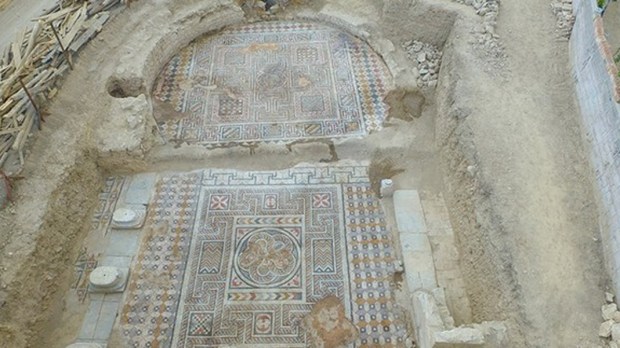A routine site inspection turned into an archaeological excavation after ancient Roman mosaics were discovered in Turkey’s southwestern Konya province. The landowner, identified by the Daily Sabah as Adem Kalender, applied for a building permit, but was unable to begin his construction due to officials marking the site as “protected.”
Mustafa Arabacı, Headman of the Ladik neighborhood, reported to Ihlas News Agency “Excavations have revealed that there had been an ancient gymnasium here.” The word gymnasium originally meant “a place to exercise while naked.” The Roman culture adopted this Greek tradition and adapted it. Gymnasiums became a place where young soldiers could train for battle and eventually expanded to contain bathhouses, which the ancient Romans became famous for.
While the archaeologists have not identified the age of this gymnasium, the city of Laodicea is known to have existed from the Apostolic Age (the years 33 – 100).
The land in question is part of the region that contains Laodicea, an ancient Roman city that held one of the seven churches of Asia mentioned in the Book of Revelation. For this reason, the ancient city is on the tentative list of the UNESCO World Heritage Sites in Turkey.
In the Book of Revelation John, while he is in captivity at Patmos, is commanded by a heavenly voice to write letters to the seven Asian churches. To the Church in Laodicea he wrote:
“I know your deeds, that you are neither cold nor hot. I wish you were either one or the other! 16 So, because you are lukewarm—neither hot nor cold—I am about to spit you out of my mouth.” Revelation 3:15-16
Revelation was written during the Apostolic Age, when the Roman emperor Domitian proclaimed himself a God and required the worship of emperors and dynastic families — although the edict exempted Jews and early Christians (who were predominantly converted Jews) whose religion would not tolerate the worship of a man.
Bible Archaeology explains that the early Christians were viewed by the ancient Romans as a sect within the Jewish faith. As more gentiles (non-Jewish people) converted to Christianity they were no longer seen as such and the Christians’ privileged status as Jewish monotheists was removed.
Mark R. Fairchild of Huntington University explains this quote in historical context:
The difficulties that this placed upon the Christians of Asia were expressed in detail throughout the Book of Revelation. Those who refused to worship the image of the beast (the emperor) were killed. Christians could no longer buy or sell unless they had taken the mark of the beast (Revelation 13). The pressure upon rich Christians to maintain their wealth was intense. Since a great deal of Laodicea’s wealth depended upon trade, the Christian merchants were in a quandary. Would they cooperate with the imperial cult and maintain their trade associations, or would they forswear Domitian and reaffirm their faith in Christ? Many of the Laodicean Christians compromised their faith in such ways that the writer of the apocalypse could say, “I will spit you out of my mouth” (Revelation 3:16).

